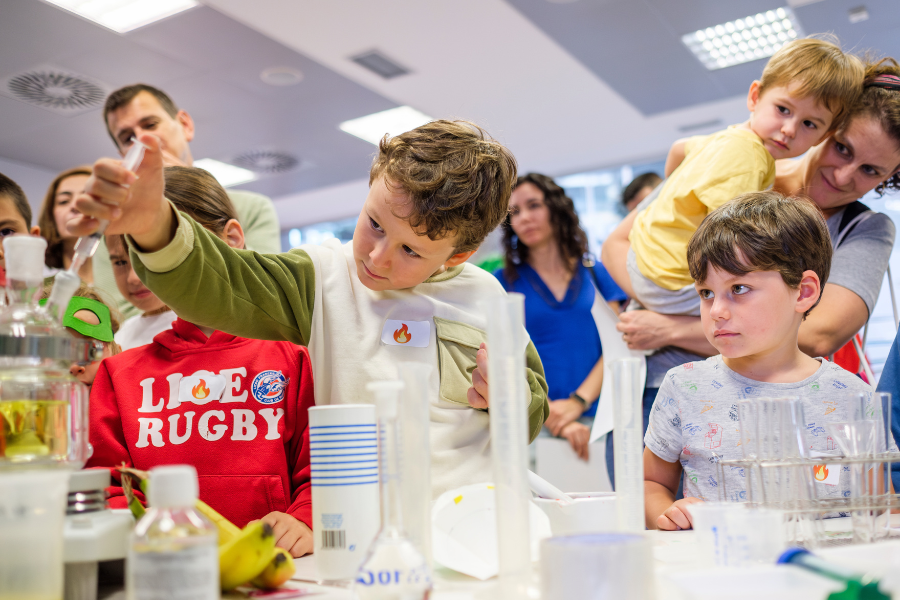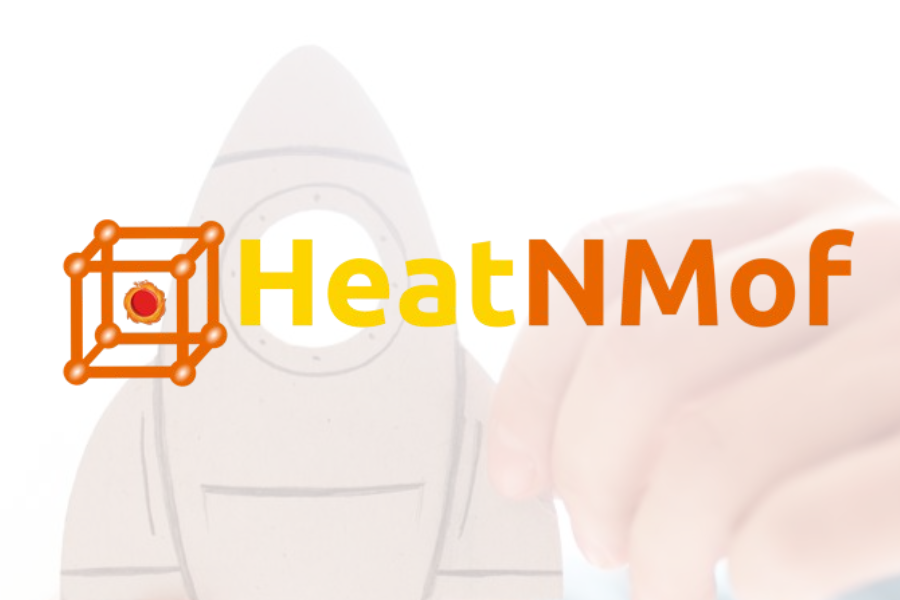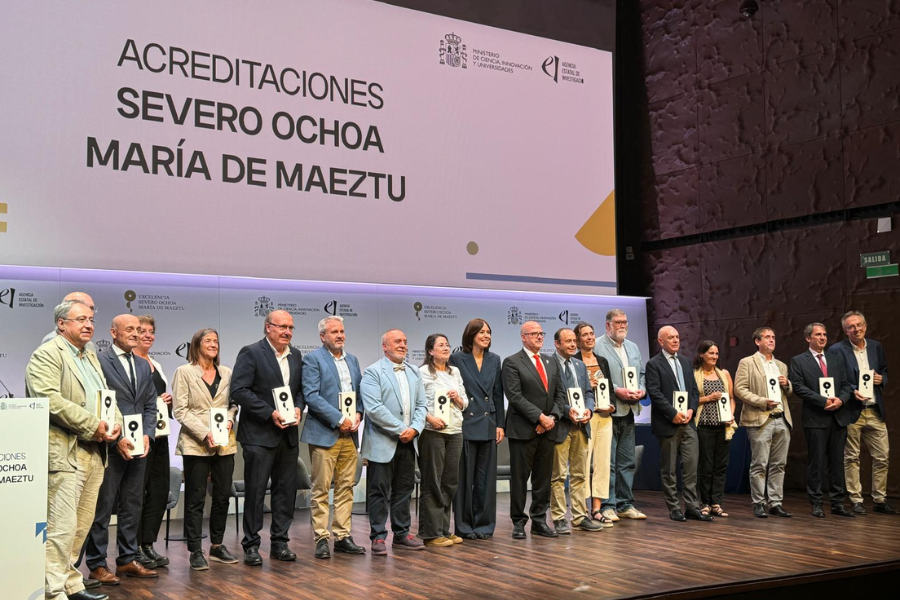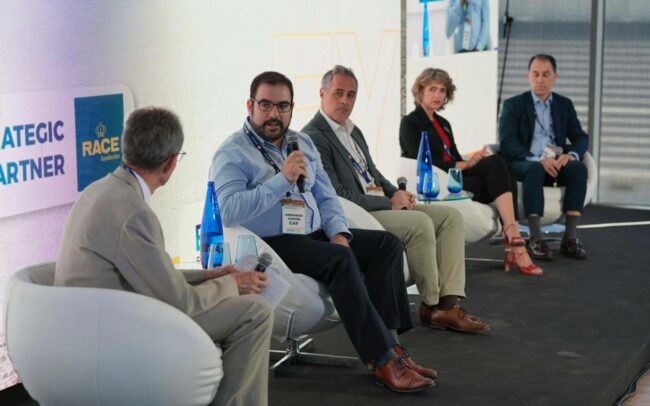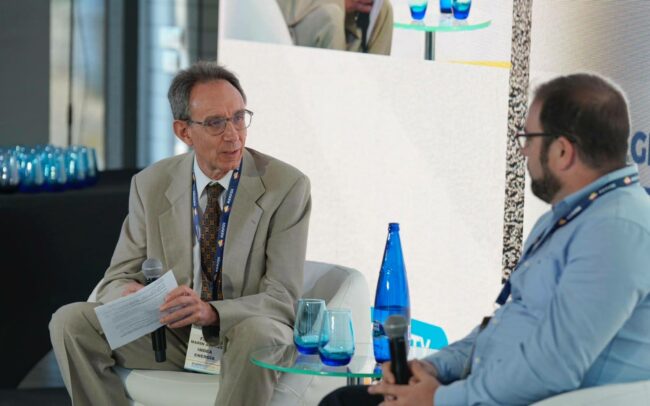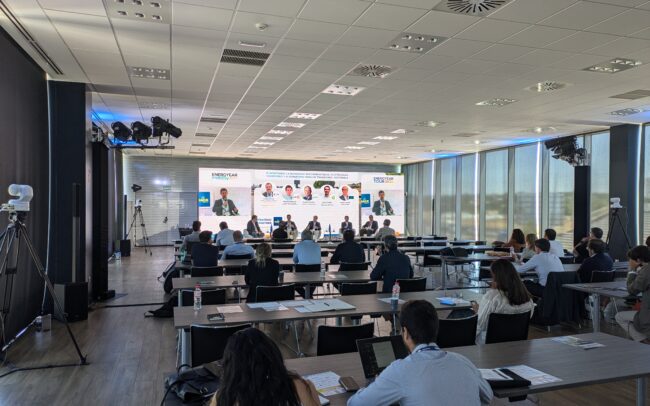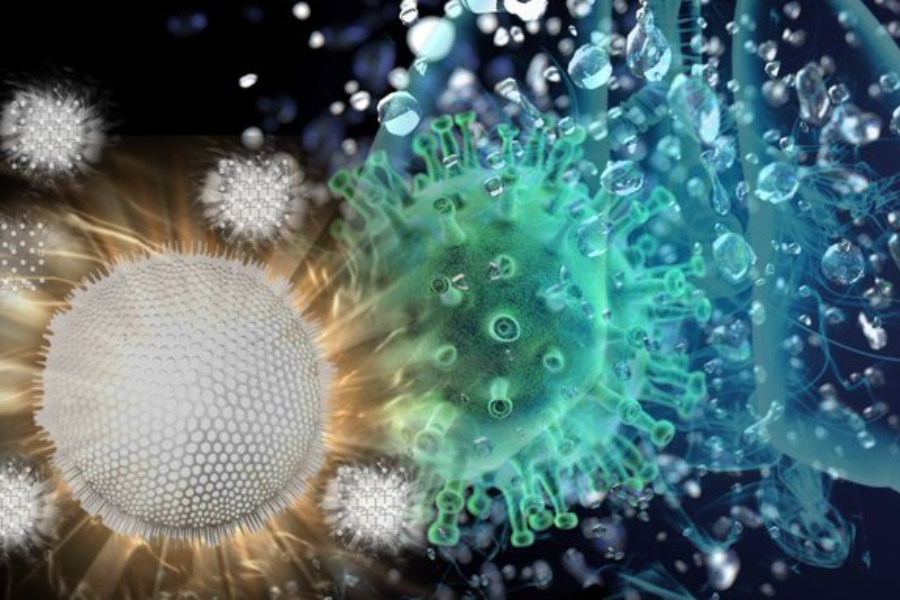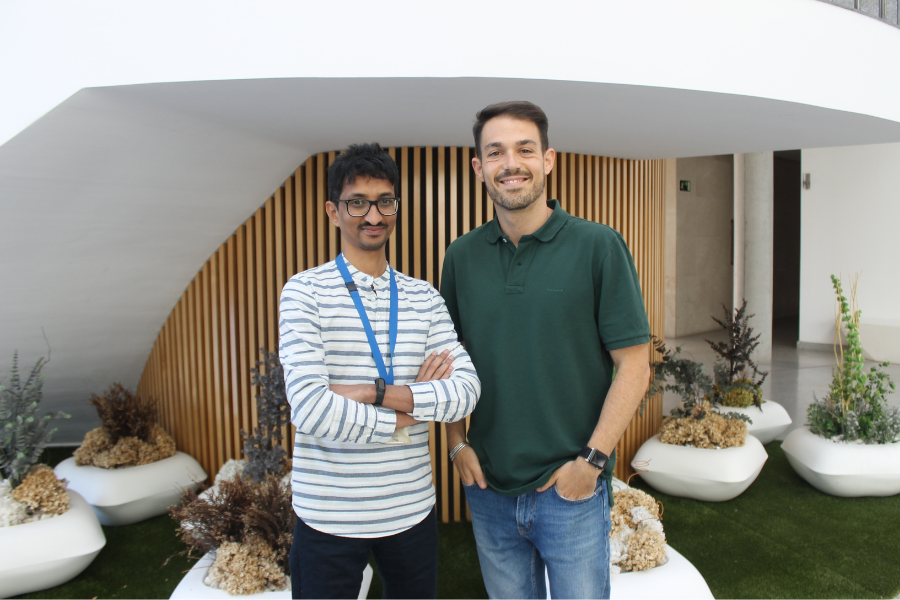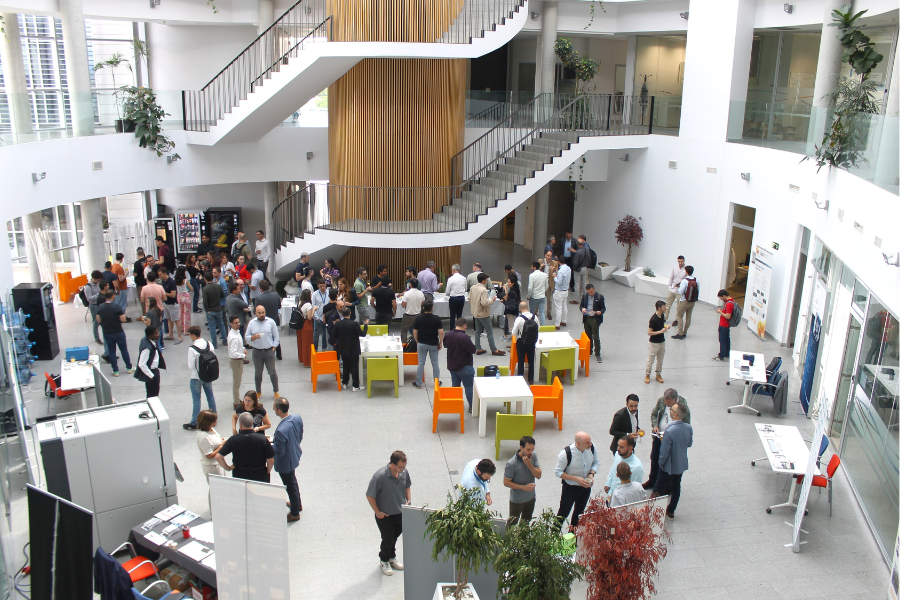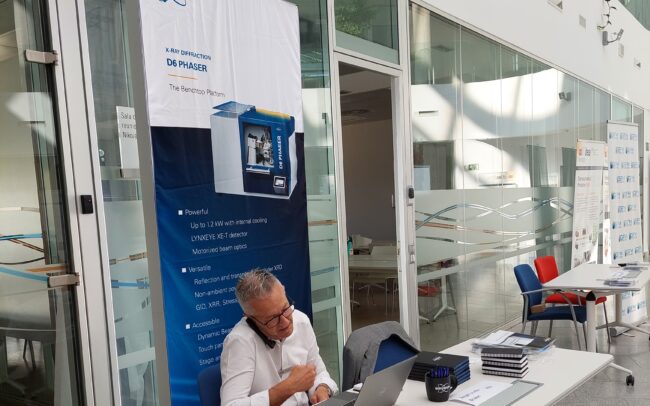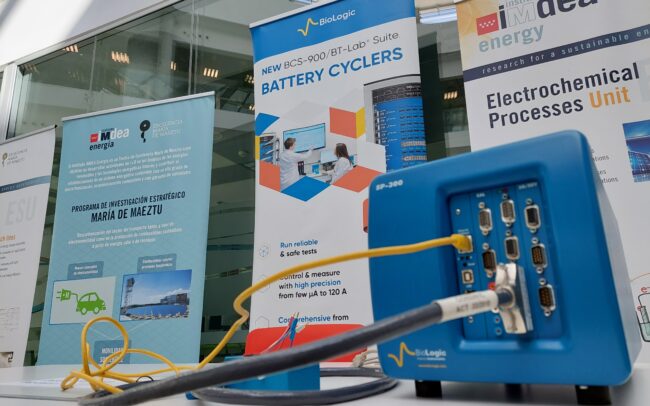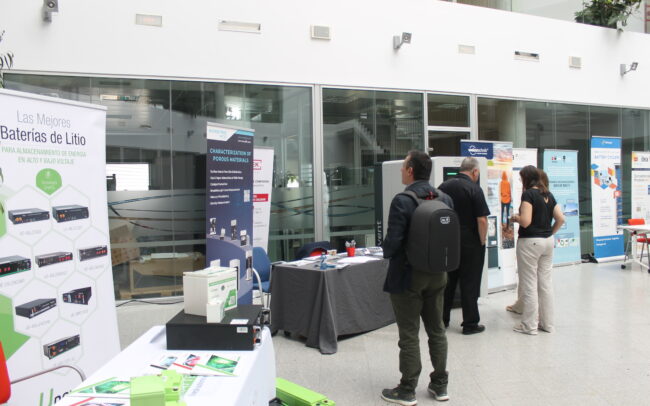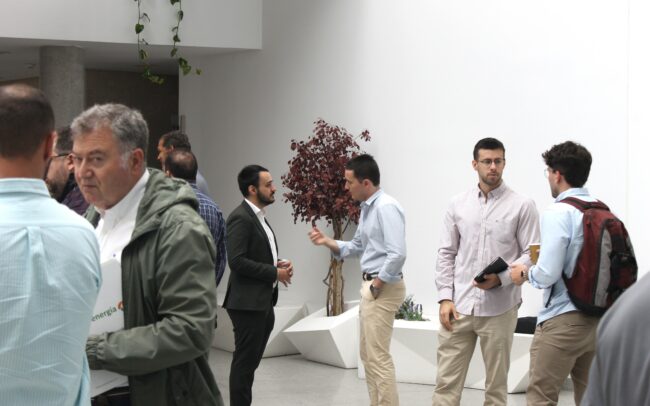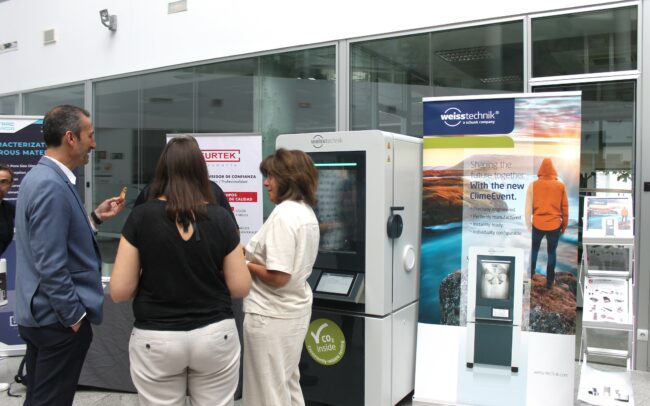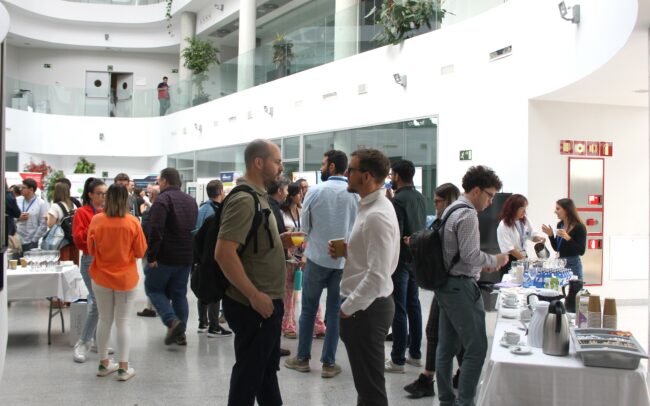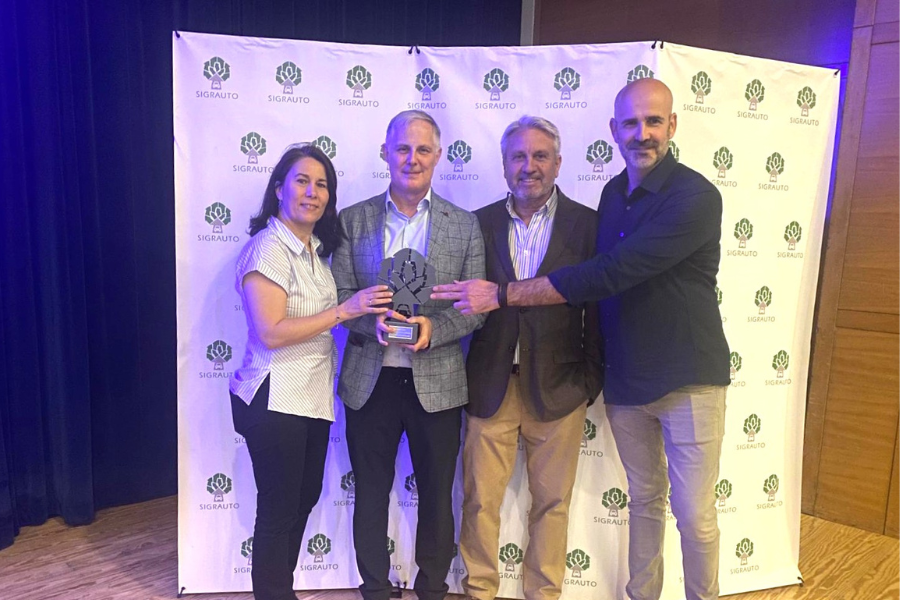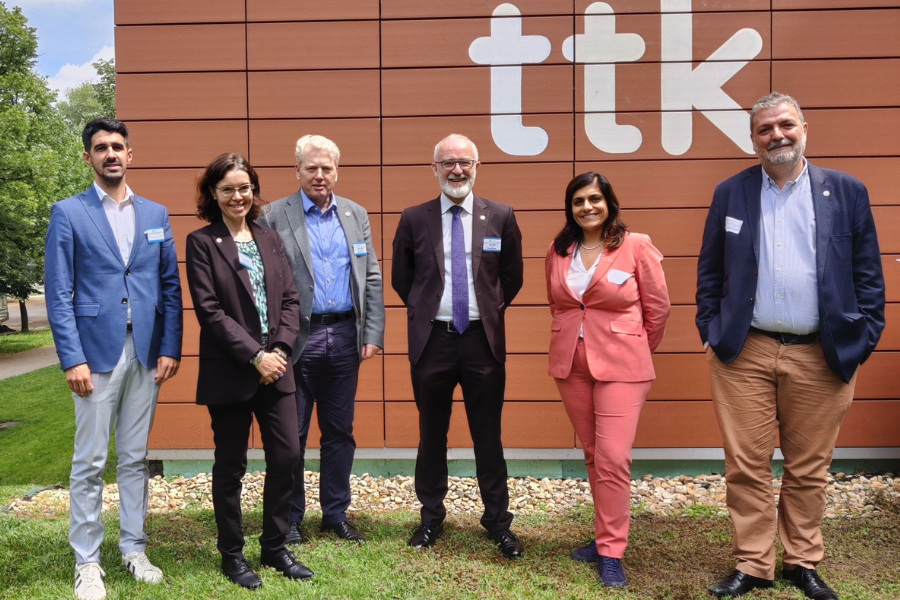HeatNMof project results highlight versatility of MOFs for applications from pharmaceutical therapy to catalysis
The HeatNMOF project, coordinated by IMDEA Energy, was focused on developing multifunctional nanocomposite materials by combining the highly porous and versatile structure of biocompatible nano-Metal-Organic Frameworks (nanoMOFs) with plasmonic and magnetic inorganic nanoparticles (iNPs). These composites are designed to offer exceptional drug payloads with controlled release capabilities while also providing specific control of reactions within living organisms, such as drug delivery triggered by photothermal or alternating magnetic field (AMF) heating. During the last 5 years, consortium efforts have been dedicated to synthesizing MOFs and MOF composites with a focus on controlling specific properties such as size, porosity, functionality, and their applications in drug delivery, catalysis, and antibacterial activity. Recent research emphasizes several methods for synthesizing nanosized MOFs and their composites. For instance, nanosized UiO-66 MOFs were synthesized using halide ions to control morphology and size, achieving high crystallinity and stable colloidal properties, which are crucial parameters for effective drug delivery (Nanoscale, 2022, 14, 6789). Another study introduces novel antibacterial MOFs, IEF-23 and IEF-24, which are solvothermally synthesized and show promising activity against Staphylococcus epidermidis and Escherichia coli (Nanomaterials, 2023, 16, 2294), emphasizing the role of tricarboxylate linkers and metal cations in therapeutic applications. The concept of isoreticularity is explored in another study (Microporous Mesoporous Mater., 2024, 367, 112968), enhancing the surface area and pore volume of a gallate-ligand-based MOF, demonstrating the importance of structural modifications to improve drug loading and release. Additionally, a highly porous Hf-tetracarboxylate porphyrin-based MOF was synthesized using a microwave-assisted method, highlighting the efficiency and scalability of this approach for catalytic applications (Mater. Adv. Today, 2023, 19, 100390). Moreover, a study on metal-sulfur bonded MOFs with Fe(III) expands the scope of S-based MOFs, focusing on electronic properties and their potential in controlled drug release (J. Mater. Chem. A., 2023, 11, 23909).
Some research groups of the consortium have focused on integrating MOFs with iNPs to develop new-generation composite materials with outstanding drug encapsulation and externally (light and/or AMF) controlled drug delivery capability. Two main strategies have been employed, particularly involving plasmonic NPs. First, Au NPs (Chemistry-a European Journal, 2024, 30, e202400442) and PtAg nanoclusters (Nanoselect 22021, 2, 758; Small, 2023, 19, 2206772) were grown within the porosity of MIL-88B-NH2 and ZIF-8 showing high catalytic activity and potential applications in energy and drug delivery. Secondly, a novel approach involves the creation of microporous plasmonic nanocomposites by using gold bipyramids as seeds for the growth of MOFs like PCN-224 (Small structures, 2024, 5, 5, 2300464). The control over the MOF shell thickness impacts the thermoplasmonic properties, enhancing thermal confinement and supporting applications in intracellular drug release and photodynamic therapy.
Advanced characterization techniques are critical in these studies, with Electron Tomography being widely used for 3D structural analysis of these nanomaterials, providing in-depth insights into the complex architectures of MOF@iNPs composites (Nanoscale, 2023, 15, 5391).
For instance, a gold nanostar core in a polymer-stabilized ZIF-8 MOF shell, enabling NIR-driven photothermal cyclization inside living cells for the spatial and temporal activation of prodrugs, was visualized through fluorescence microscopy (ACS Nano, 2021, 15, 10, 16924). Another light-responsive nanoscale MOF composite enabled spatiotemporal targeted drug delivery, which was demonstrated through studies in 2D and 3D cell culture (Small Science, 2024, 2400088). The fate of MOF composites in cells was also studied in details by monitoring the uptake of Zr-based MOF labeled with organic fluorophores in HeLa cells, revealing that nanoparticle clearance is driven more by cell proliferation than exocytosis, which has implications for MOF-based drug delivery applications (Environment & Health, 2023, 1, 270). Moreover, it was demonstrated that coating MIL-100(Fe) nanoparticles with cell membranes from a human triple-negative breast cancer (TNBC) cell line improves their stability, cellular uptake, and cytotoxicity, suggesting their potential as targeted therapies for TNBC (Nanomaterials, 2024, 14, 784).
Another potential therapeutic application was found for nanoMOFs. Particularly, the mesoporous iron(III)-trimesate MIL-100 serves as anti-COVID-19 agent, given its significant antiviral effects and high biocompatibility (ACS Applied Materials and Interfaces, 2024, 16, 25, 32118). More results will be also published in the direction of validations of different materials developed by us as drug carriers for chemotherapeutic agents with toxic effects often occurring under the magnetic activation of magnetic-MOF composites, but at exploiting local heat effects rather than direct heat damage. This will enable to reduce the requested dose of MOF-composite to achieve therapeutic effects.
Overall, advanced characterizations combined with the innovative synthetic methods underscore the versatility and adaptability of MOFs in various high-impact applications, from therapy (e.g. cancer, infection) to catalysis.
IMDEA Energy receives the statuette of the State Research Agency as a María de Maeztu Unit of Excellence
On Thursday 5 September, David Serrano, Director of IMDEA Energy, participated in the Severo Ochoa/María de Maeztu awards ceremony, organised by the State Research Agency, where he received our statuette in recognition as a María de Maeztu Unit of Excellence.
In 2020 Institute IMDEA Energía obtained this accreditation granted by the Ministry of Science and Innovation through the State Research Agency. The Severo Ochoa/María de Maeztu programme identifies and promotes high-impact research carried out in R&D centres in our country and was a recognition of IMDEA Energy’s track record of excellence and its human team, as it became the first centre to obtain the accreditation in the energy sector as a whole.
IMDEA Energy coordinates several panel discussions at EnergYear Mobility 2024
Javier Dufour and Félix Marín, from Institute IMDEA Energía, moderated two panel discussions at the first Spanish edition of the EnergYear Mobility 2024 sustainable mobility congress held at the Jarama Circuit in Madrid on 10 and 11 July, which featured prominent speakers from the business world:
Fuelling mobility: biofuels, electricity, hydrogen and alternatives for sustainable transport. Speakers:
- Ignacio Zaballos, Responsible for Electric Mobility – Corporate Network, Galp
- Franz Bechtold, Business Developer, Lhyfe
- Tomás Liniers, Mobility Manager, ReNew Spain
- David O’Hana, Director West-Med Fuel Supply, BP
- Moderator: Javier Dufour, Research Professor and Head of the Systems Analysis Unit, IMDEA Energía.
The panel discussed the advances in the supply of clean energies for different types of transport vehicles, either through their electrification or through the total or partial use of sustainable fuels: green hydrogen, biofuels, fuels obtained from waste treatment and synthetic fuels with a low carbon footprint; some of which are the subject of development work by centres such as IMDEA Energía and others that are already manufactured by entities such as those represented by the participants in the debate.
Sustainable mobility: innovation and technological alternatives applied to mobility: towards a cleaner and more efficient future. Speakers:
- Armando Ansón, Zero Emission Innovation Program Manager, CAF
- Javier Albarrán, General Manager, Medusa Alternativas Eléctricas
- Teresa Parejo, Sustainability Manager, Iberia
- Miguel Ángel Alonso Juliá, Director of Engineering, Alsa
- Moderator: Félix Marín, Head of Technology Development and Transfer, IMDEA Energía
The panel began with a presentation of the current situation of the different transport sectors: air, rail and road, and developed the experiences of the participants and the practical cases that are already in operation to contribute to decarbonisation and to make better use of existing infrastructures in order to avoid duplication and save costs. It was also highlighted the need to maintain collaboration with research centres to continue improving existing technological solutions and to seek new ones that contribute to the sustainability of transport.
The event was attended by more than 300 people, showing that sustainable technologies are a hot topic of interest for specialists and the general public and pointing the way for further research and development.
MOFs, an innovative ‘shield’ to fight COVID
The global pandemic of COVID-19, caused by the severe acute respiratory syndrome coronavirus 2 (SARS-CoV-2), has had an enormous social and economic impact worldwide, making it imperative to design new therapies to combat its spread.
In this context, several cutting-edge nanotechnologies have become promising tools to treat infectious diseases such as COVID. So far, the scientific community has moved towards antiviral prophylaxis, focusing on state-of-the-art nanovaccines such as messenger RNA vaccines, whose reliability has been demonstrated through more than 13 million doses administered since 2019.
It has been observed that the highest anti-COVID-19 activities have been achieved by different metal-based complexes and/or nanoparticles. Among the most studied emerging nanomedicines, metal-organic frameworks (MOFs) have attracted much attention in various areas (catalysis, separation, gases, etc.), including biomedicine as effective drug delivery systems. This new class of nano-scale biomaterials offers several advantages such as chemical and structural versatility, controlled release of active ingredients (e.g. drugs, nucleic acids, enzymes) under physiological conditions as well as the absence of proven toxicity in vitro and/or in vivo (e.g. cells, rodents, fish). However, despite all these favourable characteristics observed and the therapeutic results previously achieved with other pathologies (e.g. cancer, diabetes, or even wound healing), MOFs have not been investigated in depth for antiviral purposes, let alone to combat COVID-19.
In this context, researchers from the Advanced Porous Materials Unit have presented, in the framework of the VirMOF project, a pioneering approach based on anti-COVID MOFs, evaluating their potential as agents with intrinsic and innocuous antiviral activity. The biocompatible profile of several metallic nanoMOFs has been demonstrated with an effectiveness of up to 90% viral killing in a human cell scenario.
This is the first research that demonstrates the innate role of nanoMOFs against a real infection scenario and paves the way for future preclinical and clinical research for the treatment of COVID or other challenging infectious diseases related to lung pathologies.
IMDEA Energy researchers Miguel García-Tecedor and Nagaraj Patil receive a Ramón y Cajal grant
Miguel García-Tecedor and Nagaraj Patil, researchers at IMDEA Energy, have been awarded the prestigious Ramón y Cajal contract by the Spanish Government. The Ramón y Cajal (R&C) programme of the Spanish Ministry of Science and Innovation promotes the incorporation of researchers with outstanding scientific careers in R&D centres throughout Spain. The Ramón y Cajal contract includes an annual amount to co-finance the salary for five years and additional funding for research expenses.
Dr. Miguel García Tecedor (MSc. Applied Physics, 2013, PhD. Physics 2017, both at the Complutense University of Madrid, UCM) is a researcher in the Photoactivated Processes Unit at IMDEA Energy. Miguel developed his PhD, focused on the growth and characterisation of nanostructures and their possible applications, in the Physics of Electronic Nanomaterials group at UCM. In 2015, he joined the Institute for Energy Technology (IFE), located in Kjeller, Norway, where he worked on the synthesis and characterisation of organic-inorganic compounds for solar cell passivation. In July 2017, Miguel started working at the Institute for Advanced Materials (INAM) at the Universitat Jaume I, where he worked on the development of materials and strategies for different (photo)electrochemical applications. In March 2021, Miguel joined IMDEA to continue his research focused on solar fuel generation. In 2023 he was awarded a Junior Leader La Caixa grant and the R3 certificate from the Spanish Research Agency.
Through the Ramón y Cajal grant, Miguel will continue to advance in the fabrication and characterisation of novel materials for the generation of solar fuels through photoelectrocatalytic routes, coupling chemical reactions of high interest.
Dr. Nagaraj Patil currently holds the position of Senior Researcher in the Electrochemical Processes Unit at IMDEA Energy. He obtained his MSc in Chemistry from India in 2012 and his PhD from the University of Liège (Belgium) in 2017. His PhD thesis, entitled “Multifunctional Polyelectrolytes Bearing Pendant Catechol/Quinone for Energy and Environmental Applications”, was part of the prestigious European Renaissance ITN project supervised by Professor Christine Jerome. Dr. Patil joined Institute IMDEA Energy in 2017 as a postdoctoral researcher. His work focuses on organic electrochemical energy storage, with special emphasis on an integrated approach combining synthetic polymer chemistry (redox-active polymers and conducting polymers) and applied electrochemical technologies (metal-polymer and all-polymer batteries).
IMDEA Energy’s Expert Day on Batteries brings together industry and science to explore the situation of the sector
On 20 June, IMDEA Energía held an Expert Day aimed at companies and institutions involved in the manufacture, design and testing of electrochemical devices such as batteries, supercapacitors and deionisers.
The event served as a meeting point to analyse the challenges and opportunities of the sector from a scientific and industrial point of view, through a series of expert conferences and a networking session around the exhibitors of the collaborating companies: Neurtek Instruments, weisstechnik, BioLogic, Bruker, GFM Fotovoltaica and Master Battery.
In addition to the challenges of the sector, new developments in the use and application of photovoltaic applications, networks, artificial intelligence tools for the study of ageing and thermal and electrical tests were presented.
CIRPLACAR, a collaborative project between IMDEA Energía and URJC, winner of the SIGRAUTO award for innovation in the recovery sector.
Cirplacar, a collaborative project of the URJC and IMDEA Energía has won the second prize of the 4th edition of the SIGRAUTO Awards for Innovation in Recovery, in the framework of the X National Meeting on Management and Recycling of End-of-Life Vehicles held at IFEMA Madrid.
The recognition achieved highlights the important contribution of this project to the recycling of plastic waste from end-of-life vehicles.
Cirplacar aims to develop new routes, combining mechanical and chemical processes, to increase the recycling rates of automotive plastic waste, in accordance with Spanish and European circular economy strategies.
This project, coordinated by Professor Rafael García Muñoz, professor of Chemical Engineering at the Universidad Rey Juan Carlos, is funded by the State Research Agency within the European Union’s Next Generation programme.
[/tatsu_text]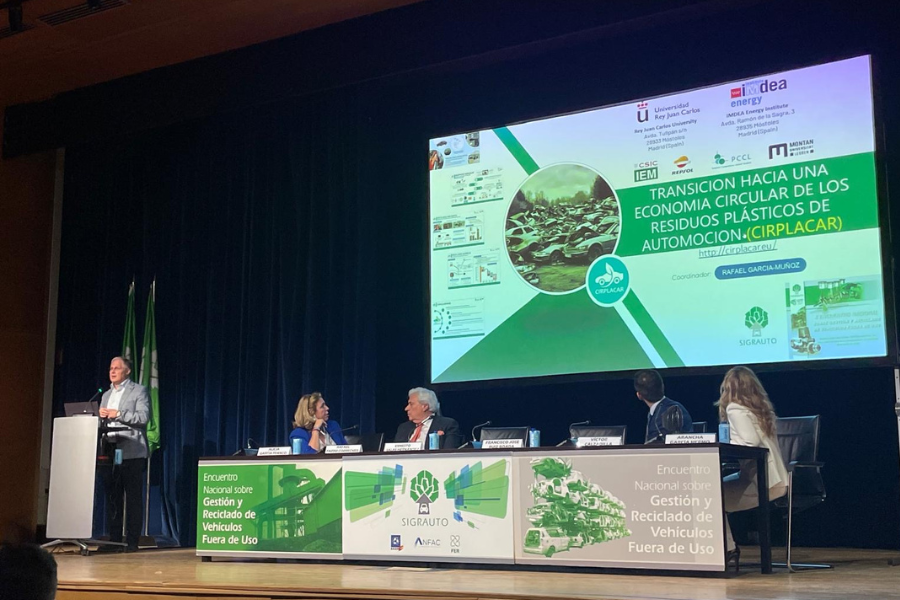
Javier Dufour, researcher of IMDEA Energy, new member of the Executive Board of the Hydrogen Europe Research
Javier Dufour, head of the Systems Analysis Unit at IMDEA Energy and professor at the Universidad Rey Juan Carlos, has been elected to the Executive Board of Hydrogen Europe Research as leader of the Cross-Cutting Technical Committee for a two-year term.
Hydrogen Europe Research is an international non-profit association of more than 150 Universities and Research and Technology Organisations from 29 countries across Europe and beyond, which aims to develop its activities in the European hydrogen and fuel cell sector, promoting hydrogen technologies and sustainable energy solutions for a cleaner future.
IMDEA Energy analyses together with companies and institutions the challenges of the circular economy from the perspective of bio-waste
How is the scientific and industrial sector facing the challenge of the energy transition and the circular economy?
To analyse it, this week at IMDEA Energía we have had the participation of key players from different institutions and companies in the framework of a conference on sustainable products and fuels.
After the opening of the event by the Director of IMDEA Energía, David Serrano Granados, who presented the centre and the main lines of research, scientific staff from IMDEA Energía and the Rey Juan Carlos University detailed advances and results in the processes of advanced catalytic pyrolysis of lignocellulose and the valorisation of stillage and digestate in the UPGRES Project.
Estibaliz Castillo Ovejero, Senior Scientist in Circular Economy at Repsol, and Luis Alberto Sebastián González, Technical Director of Genia Bionergy, explained how the company works with bio-based waste and its integration in refinery processes, while Marisa Hernández Latorre, CEO of Ingelia, presented hydrothermal carbonisation to the audience.
For her part, Susana Pelegrin Preixens. Deputy Technical Director, FCC Ámbito, spoke about the importance of waste as raw materials, and Jesús María Lata Pérez, Technology Director at Sener, highlighted the role of technology in industrial processes.
The meeting ended with a round table discussion in which speakers and attendees resolved queries and debated ways to promote the technological, economic, energy, industrial and social challenge of moving towards a more sustainable society.
ÚLTIMAS ENTRADAS
- IMDEA Energy brings together the SOLENER CM project consortium to analyse upcoming milestones in the solar-wind sector
- The PREDFLEX-CM project holds its first-year review meeting at IMDEA Energy
- IMDEA Energy holds the 14th young researchers workshop
- IMDEA Energy and MathWorks bring together experts to tackle the challenges of modeling and simulation in complex energy projects
- IMDEA Energy Plays a Key Role in the First International Conference Promoting Women’s Research in MOFs


